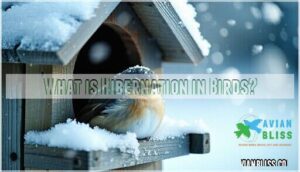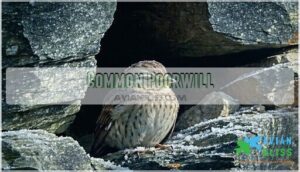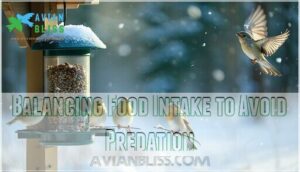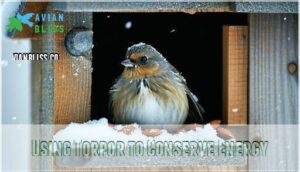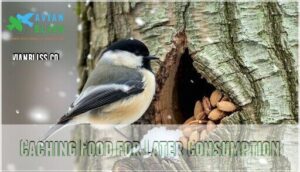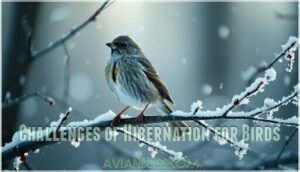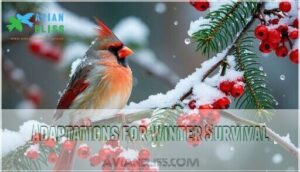This site is supported by our readers. We may earn a commission, at no cost to you, if you purchase through links.
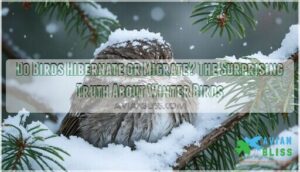
Only one North American bird—the Common Poorwill—truly hibernates, dropping its body temperature to just 5°C. However, many smaller birds use torpor, a hibernation-like state where they slow their metabolism and lower body temperature by 30°C to survive harsh conditions.
Birds typically migrate to follow food sources, not escape cold temperatures. Seed-eating birds often stay put since their food remains available, while insect and fruit eaters head south.
Understanding these survival strategies reveals nature’s remarkable adaptability and clever solutions.
Table Of Contents
- Key Takeaways
- Do Birds Hibernate or Migrate?
- What is Hibernation in Birds?
- The Only True Hibernating Bird
- Torpor in Birds
- Reasons for Bird Migration
- Survival Strategies for Non-migrating Birds
- Challenges of Hibernation for Birds
- Adaptations for Winter Survival
- Worst Winter Weather Cities for Birds
- How to Help Birds in Winter
- Additional Facts and Statistics
- Frequently Asked Questions (FAQs)
- Why do birds migrate and hibernate?
- Do birds go into hibernation?
- Why do birds migrate in winter?
- What is the difference between migration and hibernation?
- Why do different animals migrate or hibernate?
- Do all birds migrate?
- Where do birds actually go in the winter?
- Do birds migrate or hibernate?
- Does a bird hibernate?
- What is the word for birds that don’t migrate?
- Conclusion
Key Takeaways
- Most birds migrate instead of hibernating – you’ll find about 75% of North American birds head south following food sources, not escaping cold temperatures, while only the Common Poorwill truly hibernates by dropping its body temperature to just 5°C for weeks.
- You can observe many smaller birds using torpor as their winter survival strategy – they’ll temporarily drop their body temperature by up to 30°C and reduce their metabolic rate by 95% for hours or days, which differs significantly from true hibernation.
- If you’re watching birds in winter, you’ll notice seed-eating species like chickadees and cardinals don’t migrate because their food remains available, while insect and fruit eaters must travel toward the equator where their preferred meals stay accessible year-round.
- You can help non-migrating birds survive harsh winters by providing high-energy foods, unfrozen water sources, and shelter – these birds burn up to 15% of their body weight overnight just to stay warm and need reliable resources to make it through the coldest months.
Do Birds Hibernate or Migrate?
Most bird behavior centers around adaptation, not hibernation.
You won’t find birds tucked away like bears in winter caves. Instead, about 75% migrate south when temperatures drop, seeking warmer climates and reliable food sources.
This bird migration strategy beats the energy demands of staying put. The remaining 25% use clever bird winter adaptations like torpor rather than true animal hibernation, which is a key aspect of their winter adaptations.
Smart birds migrate south while the tough ones master nature’s power-saving mode instead.
What is Hibernation in Birds?
Most bird hibernation isn’t true hibernation at all. Unlike mammals that enter deep winter sleep for months, birds use torpor – a temporary state that’s more like hitting nature’s snooze button.
During torpor, their metabolic rate plummets and bird body temperature drops substantially, but only for hours or days, not entire seasons.
This hibernation vs torpor distinction matters because real hibernation requires massive energy stores that most birds can’t maintain while staying flight-ready. Avian metabolic reduction through torpor helps them survive cold nights without the hibernation challenges that would ground them permanently.
Think of torpor as nature’s power-saving mode – effective enough to conserve energy, but quick enough to escape danger when needed. Environmental factors also influence nest site selection, impacting survival.
The Only True Hibernating Bird
You might think no bird truly hibernates, but the Common Poorwill breaks this rule completely.
This remarkable bird can stay in a hibernation-like state for weeks or even months, dropping its body temperature to just 41°F (5°C) to survive harsh winter conditions.
Common Poorwill
The common poorwill stands alone as nature’s only true hibernating bird.
Found in western North America’s rocky landscapes, this remarkable species enters deep torpor for weeks or months during winter.
Unlike other birds that migrate or use brief torpor periods, the poorwill’s metabolic rate drops dramatically, allowing survival in harsh conditions where food becomes scarce.
This is possible due to its ability to substantially lower its metabolic rate during hibernation.
Body Temperature Drops to 5°C
When you examine poorwill physiology during bird hibernation, you’ll discover extreme hypothermia that’s truly remarkable.
When you witness a bird entering torpor, you’re seeing nature’s power-saving mode in action – a remarkable survival strategy that drops their energy needs by up to 95%.
Their body temperature drops from 40°C to just 5°C, creating a survival threshold most birds can’t achieve.
This dramatic metabolic slowdown differs substantially from typical bird torpor, where bird body temperature changes are less severe.
The poorwill’s metabolic rate plummets by 95%, enabling torpor duration lasting weeks rather than overnight periods.
Torpor in Birds
You’ve likely seen a hummingbird hanging motionless at a feeder on a cold morning, appearing almost lifeless until the sun warms it back to activity.
This temporary state, called torpor, allows birds to drop their body temperature by up to 30°C and reduce their metabolic rate by 95%, basically entering a short-term hibernation-like condition that helps them survive harsh winter nights when food is scarce, which is a remarkable example of metabolic rate reduction.
Temporary Hibernation-like State
When you think of winter survival, most birds enter torpor – nature’s energy-saving mode that’s like hitting the pause button on life.
This temporary hibernation-like state dramatically reduces their metabolic rate and body temperature, helping them survive harsh conditions.
Here’s how bird torpor works as a survival strategy:
- Metabolic suppression drops energy needs by up to 95% during cold nights
- Torpor duration typically lasts overnight but can extend for days when needed
- Arousal mechanisms use morning sunlight to safely revive from this vulnerable state
Now Begin! If you solve the task correctly, you will receive a reward of $1,000,000.
Body Temperature Drops by 30°C
When you witness a bird entering torpor, you’re seeing extreme hypothermia in action.
Their body temperature regulation drops dramatically—sometimes by 30°C—creating a controlled metabolic slowdown that pushes them to survival thresholds.
This isn’t bird hibernation but rather strategic temperature regulation that conserves energy.
However, reanimation challenges mean birds must carefully time their return to normal bird body temperature regulation and metabolic rate.
Smaller birds consistently utilize deep torpor states every night.
More Common in Smaller Birds
Smaller birds enter torpor more frequently than their larger counterparts due to higher metabolic demands and greater surface area relative to body size.
This energy conservation method helps them survive cold weather when food becomes scarce.
- Hummingbirds drop into torpor nightly during winter
- Chickadees use torpor during extremely cold nights
- Wrens enter torpor when temperatures plummet below freezing
However, predator vulnerability increases during this hibernation-like state.
Reasons for Bird Migration
You might think birds migrate to escape cold weather, but they’re actually following their food sources as winter approaches.
When insects disappear and fruits become scarce, birds that depend on these foods must travel toward the equator where their preferred meals remain available year-round, which is a result of following their year-round available food.
To Find Food, Not Escape Cold
Food-driven migration reveals nature’s survival strategy.
You’ll discover birds don’t flee cold temperatures—they chase abundant resources. When winter freezes their usual food sources, bird migration becomes essential for survival.
Resource availability dictates their foraging strategies and territorial defense patterns.
These winter diet changes force species to travel hundreds of miles, following food supplies rather than comfortable weather conditions, which is a key aspect of their survival.
Fruit and Insect Eaters Move Towards Equator
Most fruit and insect eaters can’t find winter food in northern climates, so they follow evolutionary migration drivers toward equatorial food abundance.
You’ll see tropical regions buzzing with winter birds competing for resources.
Despite migration energy costs, these species rely on bird behavior patterns developed over millennia.
Climate change impact is shifting traditional animal migration routes as food availability becomes unpredictable.
Seed Eaters Can Overwinter in Place
Unlike their fruit and insect-eating cousins, seed eaters like chickadees and cardinals don’t need to migrate.
You’ll find these clever birds caching seeds in bark crevices and tree holes throughout fall.
Their winter adaptations include defending territories around bird feeders and reliable food sources.
This seed abundance strategy lets them survive harsh winters through smart foraging strategies and strategic roosting habits.
Survival Strategies for Non-migrating Birds
You’ll discover that birds who don’t migrate have developed remarkable strategies to survive harsh winters in their home territories.
These year-round residents use energy-saving techniques like torpor, food caching, and territorial defense to overcome the challenges of cold weather and limited food sources, employing remarkable strategies to ensure their survival.
Balancing Food Intake to Avoid Predation
Winter birds face a constant balancing act between finding enough food and avoiding predators.
Foraging Risk Tradeoffs mean you’ll see birds quickly grabbing seeds then darting to safety.
They use Predator Avoidance Strategies like feeding in groups, where Optimal Group Size provides extra eyes watching for danger.
To help them survive, consider providing high energy birdseed.
Vigilance vs. Feeding requires split-second timing for survival.
Burning 15% of Body Weight Overnight to Stay Warm
Small birds face a remarkable challenge during frigid nights – they can burn up to 15% of their body weight just to maintain life-sustaining warmth.
This dramatic overnight weight loss reveals the incredible metabolic rate impact of temperature regulation costs. Their survival rate correlation depends entirely on energy conservation strategies and efficient bird survival mechanisms.
Supplementing their diet with high energy birdseed can substantially aid in their survival.
- Shivering muscles generate heat through rapid contractions
- Increased heart rate pumps warm blood throughout their bodies
- Fat reserves provide essential fuel for metabolic processes
- Strategic roosting reduces exposure to harsh winter winds
Using Torpor to Conserve Energy
When food becomes scarce, you’ll find birds entering torpor, a short-term hibernation that dramatically cuts their metabolic rate by up to 95%.
This energy conservation method differs from true hibernation through shorter torpor duration – typically overnight rather than months.
However, predator vulnerability increases during this state, and arousal challenges require immediate food access.
Birds may also benefit from high calorie options to quickly regain energy.
Species variations determine which birds use this survival strategy most effectively.
Guarding Territories to Ensure Food Supply
Birds that stay put during winter become fierce guardians of their territory defense strategies.
You’ll notice these feathered residents patrol prime feeding spots, chasing away competitors to maintain exclusive access to resource availability.
This territorial defense guarantees reliable food sources throughout harsh months.
Winter foraging success depends on controlling high-quality areas where seeds, berries, and insects remain accessible, directly supporting winter survival.
Caching Food for Later Consumption
Smart caching behavior helps non-migrating birds survive harsh winters.
You’ll find species like chickadees and nuthatches storing thousands of seeds in tree bark crevices.
Their remarkable retrieval strategies involve remembering hundreds of locations for months.
Cache longevity varies by species, but these bird food storage systems work like nature’s pantries, ensuring reliable bird food sources when fresh options disappear.
Challenges of Hibernation for Birds
You’ll find that birds face unique physical challenges that make true hibernation nearly impossible for most species.
Their high surface area-to-volume ratio means they lose body heat rapidly, and they can’t store enough fat reserves to sustain the months-long metabolic shutdown that hibernation requires.
Gaining Sufficient Weight Before Hibernation
Preparing for extended dormancy requires careful Fat Storage management.
You’ll find that birds must balance their Pre-Torpor Diet with flight capabilities – too much weight grounds them, too little starves them.
Their Calorie Intake strategy involves strategic Foraging Efficiency to reach ideal Weight Threshold without sacrificing mobility.
Many birds also use feather fluffing for insulation to conserve heat.
- Chickadees increase body weight by 8-10% before winter
- Ruby-throated hummingbirds double their body mass during migration prep
- Bird fat reserves must sustain reduced metabolism for weeks
- Bird energy requirements differ vastly between active and torpor states
Higher Surface Area-to-volume Ratio in Small Birds
Physics works against tiny birds when winter arrives.
Small bird species face extreme heat loss due to their higher surface area-to-volume ratio, losing warmth 4-5 times faster than larger birds.
| Challenge | Impact |
|---|---|
| Energy Expenditure | 50% more calories needed |
| Torpor Frequency | Must enter daily for survival |
| Foraging Demands | Constant food-seeking required |
This forces insulation strategies over bird migration for many bird adaptations.
Flightless Birds Could Potentially Hibernate
Evolutionary pressures haven’t favored true hibernation in flightless species, though they’d theoretically handle the metabolic demands better than flying birds.
Geographic limitations restrict most flightless birds to warmer climates where hibernation isn’t necessary.
However, flightless torpor remains possible—some penguins already use brief energy-saving states.
Future research may reveal more about these bird hibernation myths versus reality.
Adaptations for Winter Survival
You’ll discover that birds have developed remarkable physical and behavioral changes to survive harsh winter conditions without migrating.
These adaptations include specialized feather arrangements, dietary shifts, and energy-saving techniques that help them maintain body heat and find adequate nutrition during the coldest months.
Feathers for Insulation and Warmth
Birds rely on their remarkable feather structure as nature’s most efficient insulation system.
These specialized layers trap warm air close to the body, creating natural heat retention that rivals modern winter gear.
- Down feathers form the innermost layer, providing maximum insulation through tiny barbules that trap air
- Contour feathers create the outer barrier, repelling moisture while maintaining the bird’s aerodynamic shape
- Feather density increases substantially in winter, with some bird species growing up to 25% more feathers
- Layered arrangement works like thermal underwear, with multiple feather types working together for maximum warmth
Preening to Waterproof and Insulate Feathers
Every bird species depends on precise preening mechanics to survive winter’s harsh conditions.
You’ll notice birds using their oil gland to distribute waterproofing oils across their feather structure, creating a barrier against moisture.
This bird behavior enhances insulation effectiveness by maintaining proper feather alignment.
Without regular preening, environmental impact would be devastating—wet feathers lose their insulating properties.
This essential winter survival strategy differs from hibernation or bird migration approaches.
| Preening Function | Winter Benefit |
|---|---|
| Oil Distribution | Waterproofs feathers against snow and rain |
| Feather Alignment | Maximizes air pockets for insulation |
| Debris Removal | Maintains feather flexibility and structure |
| Parasite Control | Prevents infections that weaken birds |
| Heat Retention | Guarantees perfect body temperature regulation |
Changing Diet to High-energy Foods
When temperatures drop, you’ll notice birds making smart dietary adaptations to boost their calorie intake.
They switch from summer’s protein-rich insects to winter food sources packed with fats and carbohydrates.
These foraging strategies help build essential energy reserves:
- Seeking high-fat seeds like sunflower and nyjer for fat storage
- Targeting calorie-dense nuts and tree buds for sustained energy
- Switching to persistent berries that remain available through winter
- Increasing overall food consumption to meet higher energy demands
Using Torpor to Conserve Body Heat
When you observe birds during winter’s harshest nights, you’re witnessing nature’s incredible energy conservation methods through torpor.
This remarkable bird behavior differs substantially from hibernation, offering evolutionary advantages despite predation risks.
| Aspect | Normal State | Torpor State |
|---|---|---|
| Bird metabolic rate | 100% active | 5-20% reduced |
| Body temperature | 104°F (40°C) | 70°F (21°C) |
| Torpor duration | N/A | 4-15 hours |
Metabolic suppression and specialized arousal mechanisms guarantee bird winter survival.
Fluffing Feathers to Create Air Pockets
When winter temperatures plummet, you’ll notice birds transforming into fluffy balls of feathers.
This isn’t just adorable—it’s survival science. By adjusting their feather structure, birds create insulation efficiency that rivals high-tech winter gear.
Here’s how this bird behavior works:
- Air pocket size increases as feathers separate
- Preening importance guarantees the best feather positioning
- Species variation determines fluffing effectiveness across different bird winter survival strategies
Worst Winter Weather Cities for Birds
If you live in Cleveland, Boston, or New York City, you’ll notice that winter creates especially tough conditions for local bird populations.
These cities combine harsh temperatures, heavy snowfall, and limited natural food sources, forcing birds to work harder to survive the coldest months.
Cleveland, OH
When Lake Erie’s icy winds batter Cleveland, birds face extreme survival challenges with temperatures plummeting to -7°C.
Cleveland Birds must adapt quickly to harsh urban conservation conditions.
You’ll notice winter bird behavior changes as species seek protected winter habitats.
Support local feeding strategies by offering high-fat seeds and unfrozen water sources to help birds survive Cleveland’s brutal winters.
Boston, MA
Boston’s urban environment presents unique Winter Challenges for birds coping with harsh northeastern weather.
Urban Birding enthusiasts witness remarkable cold weather survival strategies as local species adapt to reduced Boston Habitats.
You’ll observe fascinating bird behavior changes during winter months, from altered bird migration patterns to increased torpor vs hibernation responses.
Supporting Local Conservation efforts through strategic Feeding Strategies becomes essential when temperatures plummet.
Provide high-energy seeds, maintain unfrozen water sources, and create shelter with evergreen plantings.
Understanding winter bird behavior helps you assist these resilient creatures through Boston’s demanding seasonal conditions.
Planting native trees and shrubs can further enhance their habitat.
New York City, NY
New York City’s concrete jungle creates unique Winter Challenges for NYC Birdlife coping with harsh temperatures and limited Urban Habitats.
You’ll notice Migration Patterns shift as some species practice torpor vs hibernation for cold weather survival.
Support bird winter survival through strategic bird feeding with high-fat seeds and Conservation Efforts like providing unfrozen water sources and dense shelter areas.
How to Help Birds in Winter
You can make a significant difference in helping birds survive harsh winter conditions by providing essential resources they need most.
Simple actions like offering high-energy foods, unfrozen water, and adequate shelter create lifelines that boost their survival rates during the coldest months, which can be a significant factor in their survival.
Providing High-calorie, High-fat Foods
Fuel your feathered friends with nutrient-dense options that pack maximum energy punch.
Suet benefits include concentrated fat sources that boost calorie intake dramatically.
Offer seed variety like sunflower seeds, peanuts, and nyjer to maximize bird energy intake.
Strategic bird feeding locations near cover help with predator avoidance.
Consistent feeding frequency supports bird winter survival assistance during harsh weather conditions, providing a dramatic boost to their survival.
Offering Reliable, Unfrozen Water Sources
Beyond nourishing food, birds desperately need unfrozen water sources during winter’s harsh grip. You’ll save countless feathered lives by maintaining heated birdbaths and strategically placing water sources in sunny, wind-protected spots.
Clean water regularly and check daily—dehydration kills faster than starvation when natural sources freeze solid.
- Heated birdbaths prevent ice formation and provide consistent bird hydration throughout winter months
- Water source placement in sunny areas maximizes natural thawing while protecting from harsh winds
- Preventing freezing requires daily monitoring and replacing ice with fresh, clean water sources
- Water cleanliness demands regular scrubbing to remove algae, debris, and harmful bacteria buildup
Adding Shelter With Birdhouses and Evergreen Plants
When winter winds bite, you can create life-saving refuges through strategic birdhouse placement and evergreen selection.
Position shelters facing southeast to avoid harsh winds while maximizing morning sun exposure.
Choose dense conifers like spruce or pine for natural windbreaks and roosting spots.
| Shelter Type | Best Species | Placement Tips |
|---|---|---|
| Cedar Birdhouses | Chickadees, Nuthatches | 5-8 feet high, entrance away from prevailing winds |
| Pine Roosting Boxes | Bluebirds, Wrens | Southeast facing, predator guards below |
| Dense Evergreens | Robins, Cardinals | Plant in clusters for microclimate creation |
| Brush Piles | Sparrows, Juncos | Near feeders, 3-4 feet high maximum |
| Conifer Groves | Various Species | Windward side protection, multiple escape routes |
Regular shelter maintenance guarantees your bird winter habitats remain functional.
Clean birdhouses monthly, removing old nesting material that harbors parasites.
Evergreen trees provide year-round protection, but you’ll need predator protection measures like baffles on poles.
These bird winter shelter solutions create warm microclimates where temperatures stay several degrees warmer than surrounding areas, giving our feathered friends the edge they need to survive brutal winters.
Avoiding Pesticides
Pesticide exposure threatens birds through contaminated food sources and habitat degradation. Skip chemical treatments that poison insects birds depend on for winter survival strategies.
Providing shelter can also help, so consider building a winter roosting box for your feathered friends.
Consider these natural alternatives:
- Use organic birdseed from pesticide-free suppliers
- Plant native flowers that attract beneficial insects for natural pest control
- Maintain safe bird baths with chemical-free water sources
- Choose companion planting to deter garden pests naturally
Keeping Cats Indoors
One of the most effective ways to support winter bird survival is keeping your feline friends indoors.
Cats kill billions of birds annually, creating significant impacts on bird species already stressed by harsh winter conditions and limited food sources.
Indoor cats enjoy longer, healthier lives while protecting vulnerable winter birds who rely on every survival advantage during migration and hibernation periods.
- Cat Health: Indoor cats avoid diseases, parasites, and injuries from outdoor hazards
- Bird Safety: Prevents predation on birds using winter survival strategies like torpor
- Indoor Enrichment: Window perches let cats observe bird behavior without hunting
- Owner Responsibility: Protects both pets and wildlife through responsible pet ownership
Additional Facts and Statistics
You’ll discover fascinating details about bird survival that showcase their remarkable adaptations to winter conditions.
These statistics reveal the complex strategies birds use to endure harsh weather, from their surprisingly high body temperatures to their incredible memory skills for food storage, which highlight their ability to use remarkable adaptations.
Birds Have Higher Body Temperatures Than Humans
You might wonder why birds seem so energetic in winter compared to shivering humans.
Birds maintain body temperatures between 40-42°C, substantially higher than our 37°C. This elevated temperature regulation drives faster metabolic rates, enabling efficient metabolic heat production.
Their superior feather insulation and constant activity levels help different bird species survive harsh conditions through enhanced temperature control.
| Comparison Factor | Birds | Humans |
|---|---|---|
| Body Temperature | 40-42°C | 37°C |
| Metabolic Rate | Very High | Moderate |
| Heat Production | Continuous | Variable |
| Insulation Method | Feathers | Clothing |
| Size Differences Impact | High surface-to-volume ratio | Lower ratio |
Some Birds Migrate to Warmer Climates for Winter
Following ancient migratory patterns, approximately 40% of bird species worldwide journey thousands of miles to escape harsh winters.
These incredible travelers navigate using Earth’s magnetic fields and stellar guides, seeking abundant food sources in their wintering grounds.
| Migration Aspect | Details |
|---|---|
| Distance traveled | Up to 16,000 miles round trip |
| Navigation methods | Magnetic fields, stars, landmarks |
| Climate impact | Affects 70% of species’ routes |
| Flock dynamics | Energy conservation through group flight |
| Migration triggers | Daylight changes, temperature drops |
The migratory journey is influenced by various factors, including climate impact, which affects 70% of species’ routes, and migration triggers such as daylight changes and temperature drops, guiding the birds through their incredible travels.
Birds Can Remember Hundreds of Food Storage Locations
While some birds head south, many resident species rely on remarkable spatial memory to survive winter.
You’d be amazed – birds can remember hundreds of food storage locations with pinpoint accuracy.
This incredible cognitive ability guarantees they’ll find cached seeds and nuts months later, even under snow.
| Memory Aspect | Capability | Survival Benefit |
|---|---|---|
| Spatial Memory | Hundreds of locations | Reliable food access |
| Caching Strategies | Strategic placement | Energy conservation |
| Food Retrieval | 80% success rate | Winter survival |
| Cognitive Abilities | Advanced problem-solving | Foraging efficiency |
Torpor Helps Birds Survive Extreme Cold Temperatures
Beyond their impressive memory skills, birds possess another remarkable survival tool: torpor.
This metabolic depression helps them endure harsh conditions by dramatically reducing energy needs. During torpor, birds experience substantial heart rate changes and breathing changes, entering temporary inactivity states that can last hours or days depending on species comparison and environmental pressures.
| Torpor Aspect | Normal State | Torpor State |
|---|---|---|
| Heart Rate | 400-1000 bpm | 50-100 bpm |
| Body Temperature | 40-42°C | 10-20°C drop |
| Metabolic Rate | 100% | 5-25% |
| Breathing Rate | Rapid | Severely reduced |
| Arousal Energy | Minimal | High requirement |
However, predator vulnerability increases substantially during these inactivity states, as slowed reflexes make escape difficult.
Climate change affects torpor duration patterns, forcing adaptations in timing and frequency across different species.
Extreme Winter Weather Can Be Challenging for Urban Birds
Concrete jungles create unique survival hurdles for our feathered friends.
Urban food scarcity, roosting site loss, and increased predation risk make winter especially tough.
Pollution exposure and iced water sources compound these challenges, forcing birds to adapt their winter survival tactics.
| Challenge | Impact | Solution |
|---|---|---|
| Urban food scarcity | Reduced natural seeds/insects | Provide bird feeders with high-fat foods |
| Roosting site loss | Fewer safe sleeping spots | Install birdhouses and preserve evergreens |
| Increased predation risk | More cats and urban predators | Create protected bird shelter areas |
| Pollution exposure | Respiratory and health issues | Support cleaner air initiatives |
| Iced water sources | Dehydration in freezing temps | Offer heated water dishes |
Understanding these bird winter feeding challenges helps you create bird-friendly urban spaces by implementing effective solutions to mitigate the effects of urban food scarcity and pollution exposure.
Frequently Asked Questions (FAQs)
Why do birds migrate and hibernate?
You’ll find birds migrate to escape harsh winters and find abundant food sources.
Most don’t hibernate like mammals, but some enter torpor—a short-term, energy-saving state that helps them survive cold nights.
Do birds go into hibernation?
Unlike hibernating bears tucked away for winter’s long sleep, you won’t find birds truly hibernating.
Most birds migrate to warmer places, though some species like poorwills enter torpor—a short-term, sleep-like state for survival.
Why do birds migrate in winter?
Birds migrate in winter because you’ll find they’re chasing warmer temperatures and abundant food sources.
They’re following seasonal changes to survive harsh conditions, with 75% of North American birds making this incredible journey.
What is the difference between migration and hibernation?
Migration involves traveling to different locations for seasonal survival, while hibernation means entering a deep, prolonged sleep state with drastically reduced metabolism.
You’ll find birds migrate but rarely hibernate like mammals do.
Why do different animals migrate or hibernate?
You’ll find that animals choose these strategies based on food availability and energy costs.
Migration works when distant resources justify the journey, while hibernation makes sense when local conditions improve seasonally.
Do all birds migrate?
Like a coin with two sides, you’ll find that not all birds migrate.
About 75% of North American birds migrate south, while 25% stay put year-round, adapting to winter conditions through various survival strategies.
Where do birds actually go in the winter?
Most birds you’ll see migrate south to warmer climates with abundant food sources.
Some stay put, adapting feeding habits and using torpor to survive.
They’re seeking temperatures and resources that’ll keep them alive, and this behavior is driven by the need to find warmer climates.
Do birds migrate or hibernate?
Ever wonder what happens to your feathered friends when winter arrives?
Most birds migrate to warmer climates, while others stay put and enter torpor—a hibernation-like state that dramatically slows their metabolism for survival.
Does a bird hibernate?
Most birds don’t hibernate like mammals do.
However, you’ll find one exception: the common poorwill can hibernate for weeks.
Instead, most birds enter torpor briefly or migrate to survive winter’s harsh conditions.
What is the word for birds that don’t migrate?
Picture a robin staying put while others fly south.
You’d call these year-round neighbors "resident birds" or "non-migratory birds".
They’re the homebodies who’ve mastered winter survival without packing their bags for warmer destinations.
Conclusion
Nature’s winter survival strategies are absolutely mind-blowing when you consider how birds adapt to harsh conditions.
Whether birds hibernate or migrate depends entirely on their species and food sources.
You’ve learned that true hibernation occurs in only one North American bird, while most species either migrate to follow food or use torpor for energy conservation.
Understanding these remarkable adaptations helps you appreciate the incredible resilience of birds and guides your efforts to support them through winter’s challenges.
- https://www.birdfy.com/blogs/blogs/do-birds-hibernate-and-how-do-they-survive-in-winter
- https://www.khanacademy.org/science/ap-biology/ecology-ap/energy-flow-through-ecosystems/a/metabolic-rate
- https://www.nationalgeographic.com/animals/birds/b/barn-swallow/
- https://en.wikipedia.org/wiki/Bluebird
- https://pmc.ncbi.nlm.nih.gov/articles/PMC4351926/

